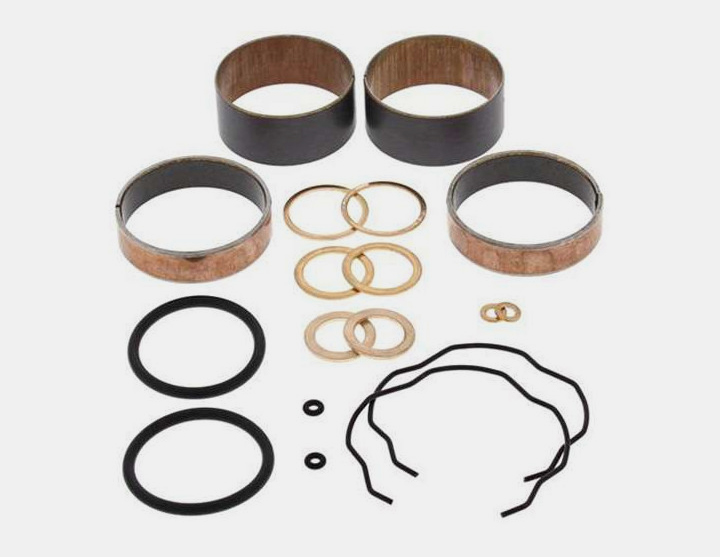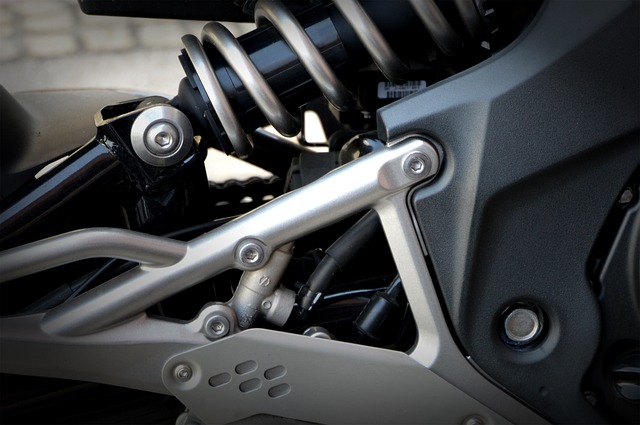
In life, there are masochists who ride hard-tails and those who like to make motorcycling rhyme with intact spine. And if you don't miss the days of rigid frames either, then this article is for you. Today, we're talking about suspension and shock absorbers. What are they made of? How do you choose them? What's the difference between the front fork and your rear unit? We'll cover all that below:
What are shock absorbers and suspension?
Before listing all the things that can go wrong with a suspension, we thought we'd start by explaining what it's made of. So, Jamy, what's a suspension? Well, it's a combination of two elements: a shock absorber - to absorb shocks - and a spring - to decompress them.
![]()
How does a shock absorber work?
Well, imagine two syringes connected by a tube. You fill only one of them with a liquid that won't rust and has a high viscosity (go for oil). The other is empty. If the catheter connecting them is very wide, you'll have no trouble circulating the fluid. Conversely, the thinner the tube, the more you have to force. And that's it, you've got a shock absorber!
And yes, the principle is exactly the same. When you compress it, a fluid flows from one chamber to another. And the more resistance you impose on this circulation, the stiffer the suspension. Conversely, the more freely the oil moves, the more supple it becomes. This is called compression adjustment. It ensures optimum contact with the ground. And since nothing is created and nothing is lost, the energy absorbed by the shock absorber during an impact is converted into heat.
What's the difference between front and rear suspension?
Unless your powers of observation are close to blindness, you'll probably have noticed that your front fork looks nothing like your rear shock absorber. Why this dimorphism? Rest assured, they're made up of exactly the same components. In both cases, you'll find :
- the shock absorber body, with its chambers in which the oil flows back and forth
- A plunger, i.e. the moving part that moves in the liquid (the plunger and its pull-tab of the syringe in our medical metaphor)
- A spring to ensure rebound after compression
- Oil, rarely extra-virgin cold-pressed oil
- A spinnaker gasket to seal the plunger from the shock absorber body.
So why is the spring submerged on the front fork, but visible on the swingarm? Quite simply, the tubes offer a key feature: guidance. This rigidity allows the wheel to move only along the axis of the fork. At the rear, the suspension doesn't have this guiding function, as the swingarm already performs it. It is therefore possible to opt for a much simpler design: the combined shock absorber/spring.
How long does a motorcycle suspension last?
Over a period of 30,000 to 40,000 kilometers, a shock absorber can live out its useful life without needing to be repaired. Once this mileage has been exceeded, you'll need to visit your garage for a thorough inspection, or even a complete overhaul. Of course, these values are indicative and must be adapted to your bike according to the gospels of the holy Builder's Manual.
What are the symptoms of worn motorcycle suspension?
The law of maximum annoyance dictates that your suspensions can play tricks on you, and this will obviously happen in the middle of a motorcycle road trip. So it's a good idea to take a look at them regularly as a preventive measure.
![]()
Behavioural signs of worn suspension:
- Motorcycle sags when you get on it: there are two possible options here. Either you're getting back on after the holidays and have underestimated the effect of the 100% Yule log diet, or your suspension springs are weak.
- Bouncing: if you feel like you're sitting on a public park spring horse, then you're probably running low on suspension oil. In fact, this is a symptom that the "cushioning" function is no longer working properly.
- Vibrations: has your wheel turned into a washing machine on the spin cycle? Your fork is too rigid and no longer dampens sufficiently. You can feel all the roughness of the road, or the defects of a badly balanced wheel.
![]()
Visual signs of suspension wear:
- Oil leaks. In this case, the culprit is most likely the oil seal. A suspension without fluid is nothing more than a spring, so you go into rocking-horse mode. Not good.
- Scratches or marks on your inner fork tube (the plunger). These rough spots are a breeding ground for suspension oil, which will ooze out a little more with every bump you take. Unfortunately, in this case, the bill can be hefty, as you'll have to replace them.
How to repair your motorcycle's suspension?
Oil-spattered suspension, weak springs, scratched fork tubes: this doesn't sound the death knell of your amortos. And yes, don't you change your bike every time your tires are flushed? In the same vein, it's a good idea to choose refurbishment over replacement (especially for your wallet).
![]()
Each item is available in our store
- Rear shock absorber spring: You can opt for an original model or a progressive spring for greater stability and riding comfort.
- Spi seals and dust covers: 99% of suspension failures are due to a worn spi seal. Fortunately, this will only cost you between €15 and €30.
- Fork tube: With repeated shocks - and off-road waffles - fork tubes are put to the test. Scratches, bumps, marks: it's time to replace them. Expect to pay around €250 each.
- Suspension oil: If the quality of the oil is important, the volume in the suspension is just as crucial.
- Reconditioning kit: If you're afraid of missing a component, then opt for a complete kit. Rings, washers, seals: it's all there.

----> All Balls 38-6048 Kawasaki KX125/Yamaha YZ125 fork reconditioning kit
How to choose your new motorcycle suspensions?
You're not too keen on rebuilding because your original suspensions are as hard as wood? Are you looking to improve performance or ride comfort? Then it's time to take a look at better-quality shock absorbers for improved handling. Here are the selection criteria:
![]()
Compatibility with your bike
Fitting new shock absorbers has to be plug&play. So, before frantically clicking on the "buy" button in the online store, double-check that everything matches: center distance, length, type of mounting, any on-board electronics, etc...
![]()
With or without separate cylinder
On a "classic" amorto, heavy use can lead to cavitation - a pompous term which simply means that your oil turns into mayonnaise. This impromptu emulsion drastically reduces the shock absorber's efficiency. So what happens? The separate cylinder contains pressurized gas (usually nitrogen) which prevents this deleterious phenomenon, guaranteeing optimum roadholding.
![]()
Preload adjustment
This setting adjusts the spring preload in order to adjust the suspension downforce. Super practical if you use your bike both for everyday solo riding and for loaded-as-a-mule duo roadtrips. The must-have for your rear amorto? The threaded combination that lets you adjust this variable precisely and easily.
![]()
Adjustable compression
Compression is the suspension's ability to absorb shock. Off-roaders prefer softer shocks to smooth out the roughness of trails, while on the road and track, more rigidity offers better handling. See what we mean? This setting is a real bonus for trail riders who navigate between asphalt and mud.
![]()
Presence of rebound adjustment
This is how quickly the suspension returns to position after being compressed. Being able to adjust this value prevents bouncing, regardless of road conditions and load. A real plus.
![]()
Linear or progressive spring
In the first case, the spring offers constant resistance regardless of how far it's compressed, while in the second, it's more rigid at the end of its stroke. This progressivity allows you to benefit from soft cushioning while avoiding heel-toeing during heavy-duty use. Nowadays, most springs are progressive.

Now you've got everything you need to repair or choose your suspension. If there's only one thing to remember? They're the key to optimum roadholding, so they're just as important as tires, chains and brakes. With that in mind, we wish you a great ride, on the road or on the trail.
.
.
.
.
Image credits: banner photo by Freepik, wheel photo on black background by Freepik, suspension zoom photo by PIRO from Pixabay
Our last posts
#interviewmotarde #etonvaoumaintenant #motardevoyageuse #voyagemoto
#hivernale #millevaches #équipementmotard #aventuresmichel
#aventuresmichel #hardefitour #raidenduro #tout-terrain
Aucun produit
